Baby’s First Flight: Helpful Tips for Stress-Free Travel
Flying with a baby for the first time can be a daunting experience for even the most seasoned travelers. The thought of navigating airports, managing security procedures, and handling mid-flight meltdowns often raises anxiety levels for parents. However, with careful preparation and the right strategies, you can turn what seems like an overwhelming challenge into a memorable family milestone. This guide provides 21 comprehensive tips to help parents feel confident and prepared as they embark on their baby’s first flight.
Traveling by air with an infant is often accompanied by a mix of excitement and worry. Will the baby be able to sleep on the plane? What happens if they cry inconsolably? How do you navigate a crowded airport while juggling baby essentials? These questions are common, but the good news is that flying with a baby can be manageable—and even stress-free—with the right approach.
This article is designed to provide parents with practical advice to make their baby’s first flight a smooth and enjoyable experience, filled with opportunities to create lasting memories. Whether you’re flying for a family vacation, attending an important event, or visiting loved ones, the tips outlined here will help reduce your stress while ensuring your baby is comfortable throughout the journey.
Preparation is key. By planning your itinerary thoughtfully, packing smartly, and understanding the dos and don’ts of flying with infants, you can transform this adventure into a positive experience for the whole family. This journey is about more than just getting from point A to point B—it’s about enjoying the ride as you share a special milestone with your little one. Let’s dive into the first set of tips: planning ahead for your baby’s first flight!
1. Planning Ahead for Baby’s First Flight
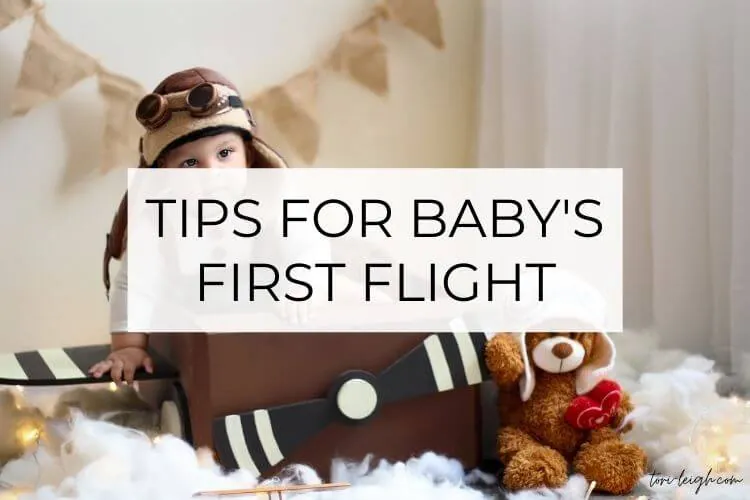
Choose the Right Flight
The foundation of a successful travel experience begins with selecting the appropriate flight. When booking tickets, consider direct flights whenever possible. Layovers can be incredibly stressful, especially when traveling with a baby, as they add time, logistics, and the potential for disruption. Direct flights minimize these complications, allowing you to focus on keeping your baby comfortable.
In addition to the flight route, timing matters. Flying during your baby’s natural sleep schedule, such as early morning or red-eye flights, can increase the chances of them sleeping for the majority of the journey. Quiet travel days, like midweek mornings, are another great option, as they typically mean less crowded airports and flights.
Understand Airline Policies
Airline policies regarding infants vary, so understanding the specifics of your airline’s rules is crucial. For example, check if your baby qualifies as a lap infant—typically under 2 years old—and what fees apply. Alternatively, you can consider purchasing a separate seat for your baby and using an FAA-approved car seat or harness such as the CARES device for extra safety.
If you’re interested in bassinets, inquire early, as these are often available only on long-haul flights and provided on a first-come, first-served basis. Bulkhead seats, where bassinets are typically installed, may have specific size and weight restrictions, so confirm these details before booking.
Prepare Necessary Documents
Traveling with a baby requires careful attention to documentation. If you’re flying internationally, you will need your baby’s passport, which can take weeks to process, so plan ahead. Domestic flights may only require a birth certificate, but it’s always wise to double-check with your airline.
If you’re traveling without the baby’s other parent, you might also need a notarized letter of consent, depending on your destination. Additionally, keep a copy of your baby’s vaccination records handy—they may be requested by airline staff or authorities in some countries.
2. Packing Essentials for Stress-Free Travel
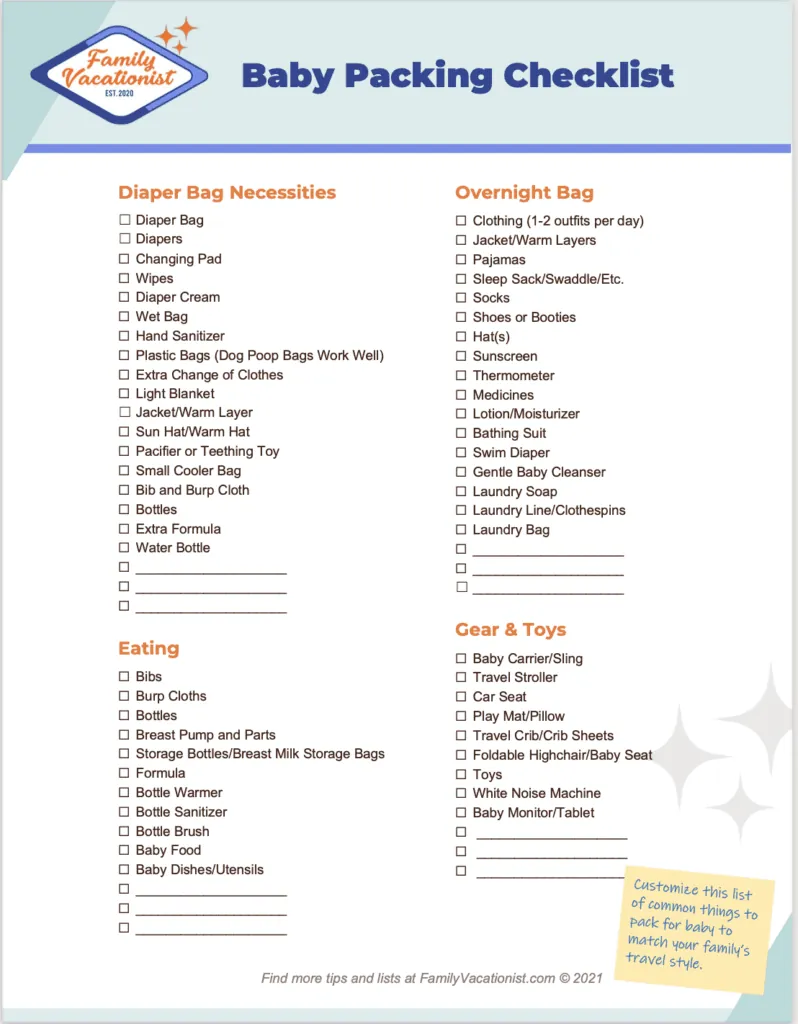
Carry-On Must-Haves
When packing for your baby’s first flight, the carry-on bag is your lifeline. It should include all the essentials you might need during the flight. Pack ample diapers, baby wipes, a changing pad, and disposable bags for soiled items. Consider carrying ready-to-use formula or breast milk stored in TSA-compliant containers, along with bottles, pacifiers, and food pouches if your baby is eating solids.
Extra clothes for both the baby and yourself are non-negotiable—you never know when a spill or surprise mess might occur mid-flight. Keep a lightweight blanket handy for warmth or as a cover while nursing, and include small toys or books to entertain your baby.
Smart Packing Tips
Packing efficiently is critical when juggling baby gear, especially during airport security screenings. Place liquids, such as breast milk or formula, in clear, TSA-compliant containers and organize them in transparent bags for easy access. Label items clearly to minimize delays during inspections.
It’s also wise to adopt a minimalist mindset when it comes to your baby’s belongings. Instead of carrying everything you might need, focus on essentials and prioritize items that are multipurpose or lightweight.
Travel Gear
Streamlining your travel gear makes navigating busy airports easier. A baby carrier or sling allows you to keep your hands free and your baby close, which can be especially helpful when navigating through security or boarding. If you prefer a stroller, opt for a compact, lightweight model that fits in overhead bins or can be gate-checked.
Additional travel gear like noise-canceling headphones for your baby, a portable white noise machine, and a travel-friendly diaper bag with multiple compartments can make your journey significantly smoother.
3. At the Airport: Navigating Security and Boarding
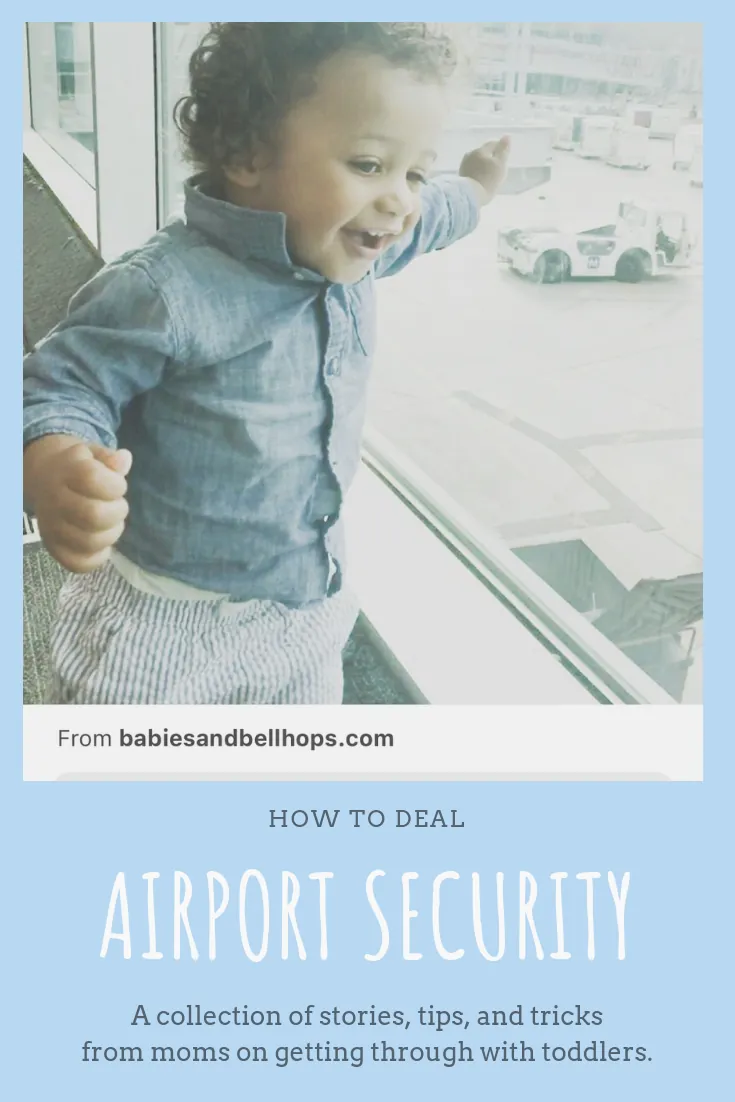
Arrive Early
Arriving at the airport early is crucial when traveling with a baby. Factor in additional time for check-in, security procedures, and boarding, as unexpected delays are more likely when traveling as a family. Extra time ensures a more relaxed pace, helping you manage your baby’s needs without feeling rushed.
Use Family-Friendly Security Lines
Most airports have family-friendly security lanes, which can expedite the screening process for parents. Familiarize yourself with TSA guidelines for baby-related essentials, such as formula, breast milk, and baby food. While these items are exempt from the 3.4-ounce liquid rule, they must still be declared during screening.
If you’re wearing your baby in a carrier or sling, be prepared to remove it for inspection. Keeping items in easily accessible compartments of your carry-on will help streamline this process.
Boarding Strategies
Airlines often allow families with young children to board early, giving you extra time to settle in and organize your space. However, some parents prefer to board last to reduce the amount of time their baby has to spend waiting in the cramped airplane cabin before takeoff. Choose the strategy that aligns with your baby’s temperament and needs.
4. In-Flight Tips: Keeping Your Baby Comfortable
Easing Ear Pressure
One of the most common concerns for parents is how cabin pressure changes during takeoff and landing might affect their baby’s ears. To help ease discomfort, consider nursing, bottle-feeding, or offering a pacifier during these phases of the flight. The sucking motion can relieve pressure on the Eustachian tubes, making the experience more comfortable for your baby.
Dressing in Layers
Airplane cabins are notorious for fluctuating temperatures, so dressing your baby in easy-to-remove layers is essential. Avoid complicated outfits with lots of buttons or zippers, and prioritize soft, breathable fabrics that can be quickly adjusted depending on the temperature.
Entertainment and Distraction
To keep your baby calm and entertained during the flight, pack a few small sensory toys, board books, or items they haven’t seen before. New or novel toys can grab their attention and keep them engaged longer. For older babies, soft toys and coloring books with mess-free markers can also be great options. Rotate toys as needed to prevent boredom.
If your baby is fussy, try simple distractions like playing peek-a-boo, singing softly to them, or offering snacks. Babies are naturally curious, and even a small object like a plastic cup might hold their attention for a while.
Managing Sleep on the Plane
Encouraging your baby to nap during the flight can make everyone’s experience more pleasant. If your flight is long-haul and your airline offers bassinets, use them to provide your baby with a safe and comfortable place to sleep. If bassinets aren’t an option, recline your seat (if permitted) and use a baby neck pillow or travel blanket for added coziness.
Bring familiar comfort items like your baby’s lovey, blanket, or stuffed animal to help them feel at ease. For babies who need white noise to sleep, consider a portable white noise machine or a downloaded white noise app played softly through your phone. Consistency is key, so replicate bedtime routines from home as much as possible, even mid-flight.
5. Handling Emergencies Mid-Air
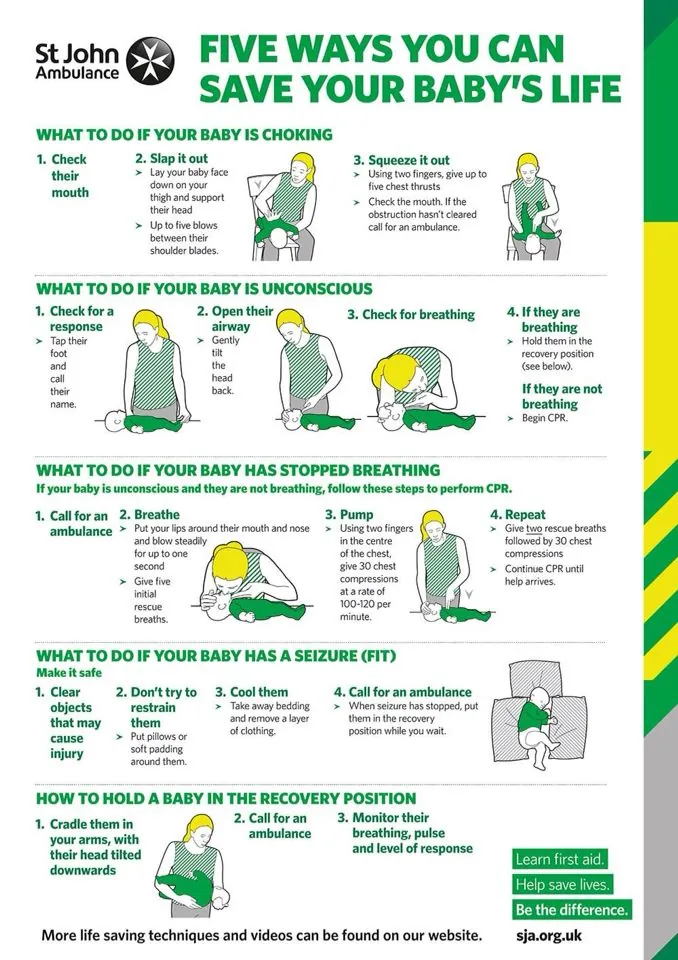
Diaper Changes
Changing a diaper mid-flight may seem intimidating, but most airplanes are equipped with changing tables in the lavatories. Pack disposable changing pads to create a clean surface, and organize your diaper kit so everything—diapers, wipes, creams—is easily accessible.
If you’re on a smaller plane without changing tables, you might need to get creative. Use your lap or the seat next to you (if empty), and always lay down a disposable pad to maintain hygiene.
Dealing with Crying or Restlessness
Babies cry—it’s normal, and sometimes unavoidable. If your baby becomes restless or starts crying mid-flight, don’t panic. Stay calm and try soothing techniques like rocking, gently bouncing, or walking up and down the aisle. Sometimes a brief walk can distract and settle an upset baby.
Accept help if offered by flight attendants or fellow passengers. Many parents have shared stories of strangers lending a hand during tough moments, and this kindness can make a big difference during a stressful situation. Remember, your baby’s mood often reflects yours, so staying calm and composed can help soothe them.
Health Precautions
Flying increases exposure to germs, so take steps to protect your baby’s health. Wipe down tray tables, seat armrests, and window areas with sanitizing wipes before settling in. Carry essential medications such as infant Tylenol or ibuprofen, as well as teething gels if applicable. If your baby shows signs of discomfort or illness during the flight, consult a flight attendant for assistance.
6. Post-Landing: Settling at Your Destination
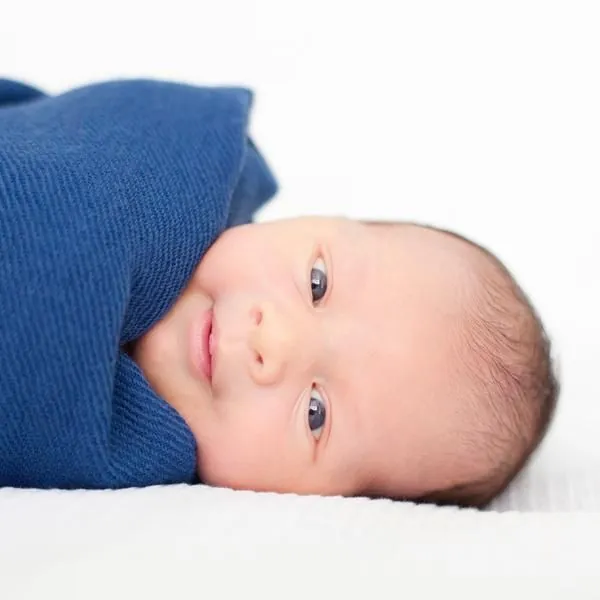
Claiming Baby Gear
Once the plane lands, retrieve your checked baby gear, such as strollers or car seats, promptly. Items that were gate-checked are usually returned at the jet bridge, while larger items may be sent to the baggage claim area. Knowing where to pick up your gear in advance can save time and reduce confusion.
Adjusting to New Environments
Air travel can disrupt your baby’s schedule, so try to re-establish their routine as soon as possible upon arriving at your destination. If you’re staying in a hotel or unfamiliar environment, create a familiar sleep setup using portable cribs, blackout curtains, or their usual bedding. Allow your baby some downtime to decompress from the travel experience, especially after a long flight.
If your destination is in a different time zone, gradually adjust your baby’s schedule to minimize jet lag. Exposure to natural light during the day can help reset their internal clock.
7. Bonus Tips for Stress-Free Travel

Stay Flexible
Traveling rarely goes perfectly according to plan, so it’s important to stay flexible. Flight delays, lost luggage, or unexpected hiccups may arise—carry extra supplies like diapers, snacks, and clothes to prepare for the unexpected. Being adaptable will help you maintain a positive attitude throughout your trip.
Leverage Airline Services
Many airlines offer family-friendly services, such as priority boarding, bassinets, discounted fares for infants, and assistance with strollers or car seats. Research these services ahead of time and utilize them to make your journey smoother.
Keep Yourself Calm
Babies are highly attuned to their parents’ emotions. If you’re stressed, they’re likely to pick up on it. Practice mindfulness or deep-breathing techniques to keep calm, and remind yourself that any challenges you face will be temporary. Focus on enjoying this experience as a family milestone.
FAQs: Answering Common Questions About Baby’s First Flight
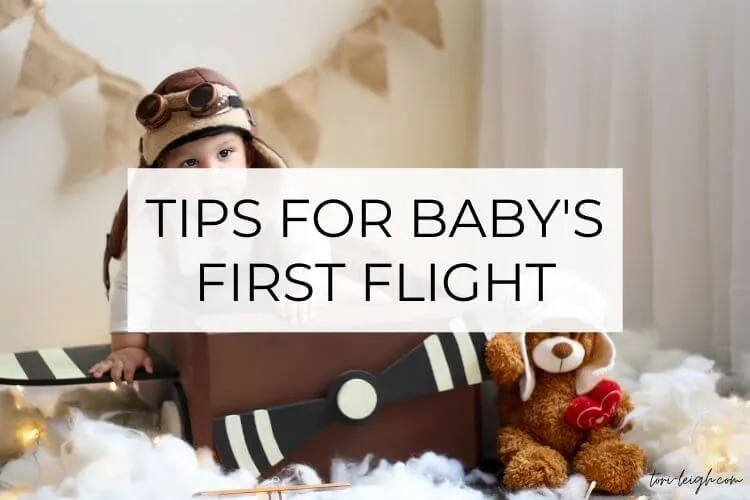
1. What age is safe for a baby’s first flight?
Most airlines allow infants as young as 7–14 days old to fly, but it’s always best to consult your pediatrician before booking a flight. Preterm infants or babies with health conditions may require special considerations.
2. Should I buy a separate seat for my baby?
While babies under 2 years old can fly as lap infants, purchasing a separate seat offers added safety and comfort. Using an FAA-approved car seat or harness ensures your baby is securely fastened during the flight, which is especially important during turbulence.
3. How do I keep my baby calm during takeoff and landing?
Feeding your baby during takeoff and landing can help alleviate ear pressure caused by cabin altitude changes. The sucking motion from breastfeeding, bottle-feeding, or pacifiers is effective at keeping them relaxed.
4. What if my baby gets sick mid-flight?
Pack a small medical kit with essentials like saline nasal spray, baby fever medicine, and a thermometer. If your baby falls ill during the flight, notify the flight attendants immediately, as they may assist with first aid or contact medical personnel on the ground.
5. Can I bring breast milk or formula through security?
Yes! TSA allows reasonable quantities of breast milk, formula, and baby food for your child—these items are exempt from the standard 3.4-ounce liquid rule. Be sure to declare them during the security screening, and pack them in clear, leak-proof containers for convenience.
Conclusion
Your baby’s first flight may feel like a daunting task, but with careful planning, the right packing strategies, and a calm mindset, it can become a wonderful adventure. Recap the key points: choose direct flights, pack efficiently, dress your baby in layers, and take advantage of airline services. Don’t forget to be flexible and embrace the unexpected moments—they often turn into cherished memories.
Flying with a baby is an opportunity to create family bonds and discover the joys of travel together. While challenges may arise, they serve as stepping stones to learning and growing as a parent. So, take a deep breath, smile, and enjoy this special journey—your baby’s first flight is a memory you’ll treasure for years to come.






